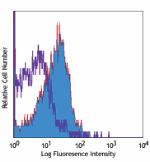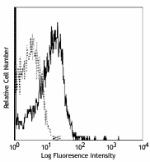- Clone
- 1B1.3a (See other available formats)
- Regulatory Status
- RUO
- Other Names
- IL-10R, Interleukin-10 Receptor
- Isotype
- Rat IgG1, κ
- Barcode Sequence
- CACCAACGCTTCAAG
| Cat # | Size | Price | Quantity Check Availability | ||
|---|---|---|---|---|---|
| 112717 | 10 µg | $369.00 | |||
CD210 is a 90-110 kD IL-10 receptor. It is a class II cytokine receptor expressed on thymocytes, T cells, B cells, NK cells, monocytes and macrophages. Ligand binding of CD210 induces Jak1 and Tyk, resulting in STAT1 and STAT3 activation. IL-10 receptor stimulation results in the inhibition of cytokine production and the costimulation of B cell proliferation and differentiation. The only known ligand for this receptor is IL-10.
Product Details
- Verified Reactivity
- Mouse
- Antibody Type
- Monoclonal
- Host Species
- Rat
- Immunogen
- Soluble mIL-10R-FLAG-His
- Formulation
- Phosphate-buffered solution, pH 7.2, containing 0.09% sodium azide and EDTA
- Preparation
- The antibody was purified by chromatography and conjugated with TotalSeq™-C oligomer under optimal conditions.
- Concentration
- 0.5 mg/mL
- Storage & Handling
- The antibody solution should be stored undiluted between 2°C and 8°C. Do not freeze.
- Application
-
PG - Quality tested
- Recommended Usage
-
Each lot of this antibody is quality control tested by immunofluorescent staining with flow cytometric analysis and the oligomer sequence is confirmed by sequencing. TotalSeq™-C antibodies are compatible with 10x Genomics Chromium Single Cell Immune Profiling Solution.
To maximize performance, it is strongly recommended that the reagent be titrated for each application, and that you centrifuge the antibody dilution before adding to the cells at 14,000xg at 2 - 8°C for 10 minutes. Carefully pipette out the liquid avoiding the bottom of the tube and add to the cell suspension. For Proteogenomics analysis, the suggested starting amount of this reagent for titration is ≤ 1.0 µg per million cells in 100 µL volume. Refer to the corresponding TotalSeq™ protocol for specific staining instructions.
Buyer is solely responsible for determining whether Buyer has all intellectual property rights that are necessary for Buyer's intended uses of the BioLegend TotalSeq™ products. For example, for any technology platform Buyer uses with TotalSeq™, it is Buyer's sole responsibility to determine whether it has all necessary third party intellectual property rights to use that platform and TotalSeq™ with that platform. - Application Notes
-
Additional reported applications (for the relevant formats) include: in vitro and in vivo blocking of ligand binding1-5. For most successful immunofluorescent staining results, it may be important to maximize signal over background by using a relatively bright fluorochrome-antibody conjugate (Cat. No. 112706) or by using a high sensitivity, three-layer staining technique (e.g., including a biotinylated antibody (Cat. No. 112704) or biotinylated anti-rat IgG second step, followed by SAv-PE (Cat. No. 405204)). For in vivo studies or highly sensitive assays, we recommend Ultra-LEAF™ purified antibody (Cat. No. 112710) (Endotoxin < 0.01 EU/µg, Azide-Free, 0.2 μm filtered).
- Additional Product Notes
-
TotalSeq™ reagents are designed to profile protein levels at a single cell level following an optimized protocol similar to the CITE-seq workflow. A compatible single cell device (e.g. 10x Genomics Chromium System and Reagents) and sequencer (e.g. Illumina analyzers) are required. Please contact technical support for more information, or visit biolegend.com/totalseq.
The barcode flanking sequences are CGGAGATGTGTATAAGAGACAGNNNNNNNNNN (PCR handle), and NNNNNNNNNCCCATATAAGA*A*A (capture sequence). N represents either randomly selected A, C, G, or T, and * indicates a phosphorothioated bond, to prevent nuclease degradation.
View more applications data for this product in our Scientific Poster Library. -
Application References
(PubMed link indicates BioLegend citation) -
- O'Farrell A, et al. 1998. EMBO J. 17:1006. (Block)
- Wang W, et al. 2004. FASEB J. 18:1043. (Block)
- Vieira PL, et al. 2004. J. Immunol. 172:5986. (Block)
- Iwashiro M, et al. 2001. P. Natl. Acad. Sci. USA 98:9226. (Block)
- Vicari AP, et al. 2002. J. Exp. Med. 196:541. (Block)
- RRID
-
AB_2876425 (BioLegend Cat. No. 112717)
Antigen Details
- Structure
- Class II cytokine receptor family, 90-110 kD
- Distribution
-
Thymocytes, T and B cells, NK cells, monocytes, macrophages
- Function
- Inhibits cytokine production, costimulates B cell proliferation and differentiation
- Ligand/Receptor
- IL-10
- Cell Type
- B cells, Macrophages, Monocytes, NK cells, T cells, Thymocytes
- Biology Area
- Immunology
- Molecular Family
- CD Molecules, Cytokine/Chemokine Receptors
- Antigen References
-
1. Ho A, et al. 1993. P. Natl. Acad. Sci. USA 90:11267.
2. Tan JC, et al. 1993. J. Biol. Chem. 268:21053.
3. Niemand C, et al. 2003. J. Immunol. 170:3263.
4. Corinti S, et al. 2001. J. Immunol. 166:4312. - Gene ID
- 16154 View all products for this Gene ID
- UniProt
- View information about CD210 on UniProt.org
Other Formats
View All CD210 Reagents Request Custom Conjugation| Description | Clone | Applications |
|---|---|---|
| Biotin anti-mouse CD210 (IL-10 R) | 1B1.3a | FC |
| PE anti-mouse CD210 (IL-10 R) | 1B1.3a | FC |
| Purified anti-mouse CD210 (IL-10 R) | 1B1.3a | FC,Block |
| Ultra-LEAF™ Purified anti-mouse CD210 (IL-10 R) | 1B1.3a | FC,Block |
| TotalSeq™-B1032 anti-mouse CD210 (IL-10 R) | 1B1.3a | PG |
| TotalSeq™-C1032 anti-mouse CD210 (IL-10 R) | 1B1.3a | PG |
Compare Data Across All Formats
This data display is provided for general comparisons between formats.
Your actual data may vary due to variations in samples, target cells, instruments and their settings, staining conditions, and other factors.
If you need assistance with selecting the best format contact our expert technical support team.
-
Biotin anti-mouse CD210 (IL-10 R)

C57BL/6 mouse splenocytes stained with biotinylated 1B1.3a, ... -
PE anti-mouse CD210 (IL-10 R)

C57BL/6 mouse splenocytes stained with 1B1.3a PE -
Purified anti-mouse CD210 (IL-10 R)

C57BL/6 mouse splenocytes stained with 1B1.3a PE -
Ultra-LEAF™ Purified anti-mouse CD210 (IL-10 R)

C57BL/6 mouse splenocytes stained with 1B1.3a PE -
TotalSeq™-B1032 anti-mouse CD210 (IL-10 R)
-
TotalSeq™-C1032 anti-mouse CD210 (IL-10 R)
